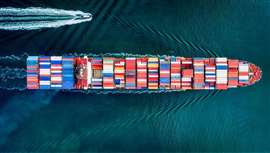IMO sets ‘monumental’ greenhouse gas strategy
10 July 2023
Calls for faster uptake of carbon-reducing technologies
 The International Maritime Organization (IMO) has revised its 2018 strategy on reducing greenhouse gas (GHG) emissions from ships, calling for a goal of net-zero emissions by 2050.
The International Maritime Organization (IMO) has revised its 2018 strategy on reducing greenhouse gas (GHG) emissions from ships, calling for a goal of net-zero emissions by 2050.
The International Maritime Organization (IMO) has revised its 2018 strategy for reducing greenhouse gas (GHG) emissions from ships, calling for a goal of net-zero emissions by 2050.
That’s a major change from the 2018 agreement, which aimed at reducing emissions from ships by just 50% in the same time horizon.
The agreement is a milestone to cut the carbon footprint of international maritime transport and ensure that the shipping sector makes a larger contribution to achieving the Paris Agreement targets, commensurate to its 3% share of global emissions.
The revised 2023 strategy sets a goal of net zero emissions from ships “by or around, i.e. close to, 2050.”
The IMO also set a goal of reducing GHG emissions from ships by at least 20%--striving for 30%--in 2030 and at least 70%--striving for 80%--in 2040, both in comparison to 2008 levels.
The strategy also sets a target of at least 5% - striving for 10% - uptake of zero or near-zero GHG emission technologies, fuels and/or energy sources by 2030.
“The adoption of the 2023 IMO Greenhouse Gas Strategy is a monumental development for IMO and opens a new chapter towards maritime decarbonization,” said IMO Secretary-General Kitack Lim. “At the same time, it is not the end goal, it is in many ways a starting point for the work that needs to intensify even more over the years and decades ahead of us. However, with the Revised Strategy that you have now agreed on, we have a clear direction, a common vision, and ambitious targets to guide us to deliver what the world expects from us.
“Above all, it is particularly meaningful, to have unanimous support from all Member States. In this regard, I believe that we have to pay more attention to support developing countries, in particular SIDS and LDCs, so that no one is left behind,” he said.
IMO is the United Nations specialized agency with responsibility for developing global standards for shipping and supporting countries to implement those rules.
The IMO also reached consensus on the need to adopt such measures by 2025 and that they should comprise a standard regulating the gradual reduction of the marine fuels’ GHG intensity, and a maritime GHG emissions pricing mechanism. The measures will be developed on the basis of a comprehensive impact assessment ensuring that they effectively reduce emissions from the sector, while contributing to a level playing field and a fair and equitable transition leaving no one behind.
The levels of ambition and indicative checkpoints take into account the lifecycle GHG emissions from marine fuels with the objective of reducing emissions within the boundaries of the energy system of international shipping, thereby preventing a shift of emissions to other sectors.
CIMAC, the global association that represents the large engine technology sector, applauded the move.
“With IMO’s Greenhouse Gas Strategy 2023, we now have the necessary framework for the maritime industry and our efforts to contribute to ongoing global endeavor to mitigate climate change and keep the Paris Agreement’s 1.5°C target within reach,” said Dirk Bergmann of Accelleron, chairman of the CIMAC Greenhouse Gas Strategy Group. “The different interests and development levels of the global community have been taken into account. That is positive.”
Dr. Daniel Chatterjee (Rolls Royce Solutions), CIMAC Vice-President Decarbonization, said the adoption of the strategy an important step for the maritime industry as a whole, even though the details still need to be defined.
“All our efforts have to be focused now on reaching the goal of a net-zero maritime sector”, Rick Boom of Woodward, CIMAC President adds: “Our industry is responsible for 3% of the global greenhouse gas emissions and we must take care that this percentage will rapidly decrease even though the maritime sector is bound to grow, due to a rising demand for global maritime transportation. With the strategy now adopted we have a long-awaited legal framework to act. The international large engine community is ready and able to drive the transformation ahead. That is one of the main takeaways from our discussions at the CIMAC Congress in June.”
CIMAC pointed out that what is still missing is the widespread availability of alternative fuels. Here, further political steps are urgently needed to create the framework to accelerate the production and distribution of alternative fuels and make them available to the maritime industry, the sooner and the more the better. Discussions how to do this are still ongoing, and CIMAC is going to give its practical and constructive input accordingly, the organization said.
POWER SOURCING GUIDE
The trusted reference and buyer’s guide for 83 years
The original “desktop search engine,” guiding nearly 10,000 users in more than 90 countries it is the primary reference for specifications and details on all the components that go into engine systems.
Visit Now
STAY CONNECTED




Receive the information you need when you need it through our world-leading magazines, newsletters and daily briefings.
CONNECT WITH THE TEAM













